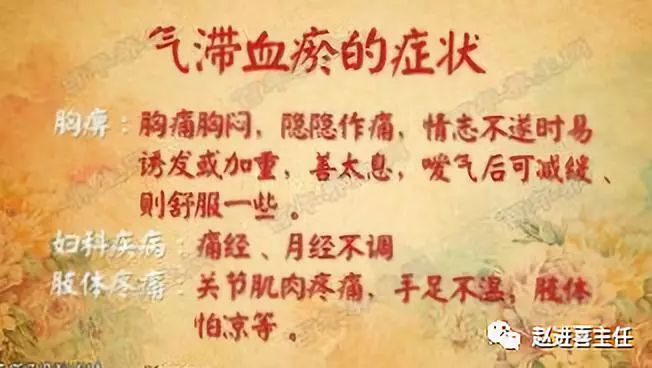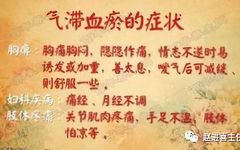“Qi stagnation and blood stasis” (qì zhì xuè yū) is a disease pattern in Traditional Chinese Medicine (TCM) that describes a pathological state. “Qi stagnation” refers to the obstruction and accumulation of “Qi” in the meridians, while “blood stasis” indicates the stagnation of blood. “Qi stagnation” can lead to “blood stasis.” Both “Qi stagnation” and “blood stasis” can exist independently or simultaneously, with each being a cause and effect of the other.

Blood accumulation caused by external injuries, known as stasis blood (yū xuè), can also lead to “Qi stagnation.” Blood serves as the carrier of “Qi,” and when the physical circulation of blood is obstructed, it naturally results in “Qi stagnation.” Mild external injuries that cause “Qi stagnation” are usually temporary, as the body automatically uses the accumulated “Qi” to “impact” the damaged area, restoring its function. For instance, when an external injury causes blood vessels to rupture or break, the “Qi” becomes obstructed and accumulates. Under the influence of the meridians and “Qi,” the local blood circulation will gradually rebuild itself while removing the “useless blood” that has leaked from the vessels, allowing the injury to heal naturally over time. In TCM, blood-activating herbs (huó xuè yào) are used to accelerate the elimination of stasis blood.
 However, if “Qi stagnation” leads to “blood stasis,” recovery becomes more challenging. It is essential to first resolve the “Qi stagnation” before the “blood stasis” can be alleviated. There are many causes of “Qi stagnation,” which may arise from external pathogenic factors such as “wind, cold, heat, dampness, dryness, and fire” (wài yáo), or it may be triggered by internal pathogenic factors (nèi yáo) due to unhealthy lifestyle choices. “Qi stagnation” can cause “Qi” to take a detour, forming local “blood stasis,” or it may create a “Qi mass” that obstructs the flow of “Qi” in other areas of the meridians.After “Qi stagnation” causes “blood stasis,” the body will, to some extent, utilize the five-element dynamic of the meridians to repair the “blood stasis” or maintain basic bodily functions. There may not be severe diseases initially, but over time, local pathological changes can develop. “What is within will manifest without,” meaning the body will inevitably experience varying degrees of discomfort, such as “sub-health” or local functional disorders. Prolonged “blood stasis” can directly lead to serious local diseases or, through the five-element transmission of the meridians, cause diseases in other areas. Conversely, if a disease has persisted for a long time, there will certainly be “blood stasis,” as “long-term illness must lead to stasis, and stasis must lead to illness.” Therefore, it is crucial to detect and eliminate “blood stasis” early to treat minor ailments and prevent major diseases.
However, if “Qi stagnation” leads to “blood stasis,” recovery becomes more challenging. It is essential to first resolve the “Qi stagnation” before the “blood stasis” can be alleviated. There are many causes of “Qi stagnation,” which may arise from external pathogenic factors such as “wind, cold, heat, dampness, dryness, and fire” (wài yáo), or it may be triggered by internal pathogenic factors (nèi yáo) due to unhealthy lifestyle choices. “Qi stagnation” can cause “Qi” to take a detour, forming local “blood stasis,” or it may create a “Qi mass” that obstructs the flow of “Qi” in other areas of the meridians.After “Qi stagnation” causes “blood stasis,” the body will, to some extent, utilize the five-element dynamic of the meridians to repair the “blood stasis” or maintain basic bodily functions. There may not be severe diseases initially, but over time, local pathological changes can develop. “What is within will manifest without,” meaning the body will inevitably experience varying degrees of discomfort, such as “sub-health” or local functional disorders. Prolonged “blood stasis” can directly lead to serious local diseases or, through the five-element transmission of the meridians, cause diseases in other areas. Conversely, if a disease has persisted for a long time, there will certainly be “blood stasis,” as “long-term illness must lead to stasis, and stasis must lead to illness.” Therefore, it is crucial to detect and eliminate “blood stasis” early to treat minor ailments and prevent major diseases.

Case Study – A uremia patient treated with Chinese herbal medicine for 6 months, with creatinine levels reduced to 220.
How does TCM understand diabetes?
What is membranous proliferative glomerulonephritis?

